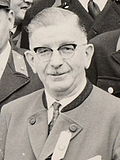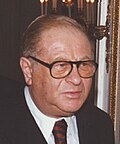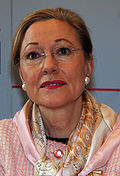| No. | Portrait | Foreign Minister | Took office | Left office | Time in office | Party | Cabinet |
|---|
| 1 | | Gruber, Karl Karl Gruber
(1909–1995) | 26 September 1945 | 26 November 1953 | 8 years, 61 days | ÖVP | Renner IV Cabinet
Figl I Cabinet–II–III
Raab I Cabinet |
| 2 | | Figl, Leopold Leopold Figl
(1902–1965) | 26 November 1953 | 9 June 1959 | 5 years, 195 days | ÖVP | Raab I Cabinet–II |
| 3 | | Kreisky, Bruno Bruno Kreisky
(1911–1990) | 9 June 1959 | 19 April 1966 | 6 years, 314 days | SPÖ | Raab III–IV
Gorbach I Cabinet–II
Klaus I Cabinet |
| 4 | | Tončić, Lujo Lujo Tončić-Sorinj
(1915–2005) | 19 April 1966 | 19 January 1968 | 1 year, 275 days | ÖVP | Klaus II Cabinet |
| 5 | | Waldheim, Kurt Kurt Waldheim
(1918–2007) | 19 January 1968 | 21 April 1970 | 2 years, 92 days | ÖVP | Klaus II Cabinet |
| 6 | | Kirchschläger, Rudolf Rudolf Kirchschläger
(1915–2000) | 21 April 1970 | 24 June 1974 | 4 years, 64 days | Independent | Kreisky I Cabinet–II |
| 7 | | Bielka, Erich Erich Bielka
(1908–1992) | 24 June 1974 | 30 September 1976 | 2 years, 98 days | Independent | Kreisky II–III |
| 8 | | Pahr, Willibald Willibald Pahr
(born 1930) | 30 September 1976 | 24 May 1983 | 6 years, 236 days | Independent | Kreisky III–IV |
| 9 | | Lanc, Erwin Erwin Lanc
(1930–2025) | 24 May 1983 | 10 September 1984 | 1 year, 109 days | SPÖ | Sinowatz Cabinet |
| 10 | | Gratz, Leopold Leopold Gratz
(1929–2006) | 10 September 1984 | 16 June 1986 | 1 year, 279 days | SPÖ | Sinowatz Cabinet |
| 11 | | Jankowitsch, Peter Peter Jankowitsch
(born 1933) | 16 June 1986 | 21 January 1987 | 219 days | SPÖ | Vranitzky I Cabinet |
| 12 | | Mock, Alois Alois Mock
(1934–2017) | 21 January 1987 | 4 May 1995 | 8 years, 103 days | ÖVP | Vranitzky II–III–IV |
| 13 | | Schüssel, Wolfgang Wolfgang Schüssel
(born 1945) | 4 May 1995 | 4 February 2000 | 4 years, 276 days | ÖVP | Vranitzky IV–V
Klima Cabinet |
| 14 | | Ferrero, Benita Benita Ferrero-Waldner
(born 1948) | 4 February 2000 | 20 October 2004 | 4 years, 259 days | ÖVP | Schüssel I Cabinet–II |
| 15 | | Plassnik, Ursula Ursula Plassnik
(born 1956) | 20 October 2004 | 2 December 2008 | 4 years, 43 days | ÖVP | Schüssel II Cabinet
Gusenbauer Cabinet |
| 16 | | Spindelegger, Michael Michael Spindelegger
(born 1959) | 2 December 2008 | 16 December 2013 | 5 years, 14 days | ÖVP | Faymann I Cabinet |
| 17 | | Kurz, Sebastian Sebastian Kurz
(born 1986) | 16 December 2013 | 18 December 2017 | 4 years, 2 days | ÖVP | Faymann II Cabinet
Kern Cabinet |
| 18 | | Kneissl, Karin Karin Kneissl
(born 1965) | 18 December 2017 | 3 June 2019 | 1 year, 167 days | Independent | Kurz I Cabinet |
| 19 | | Schallenberg, Alexander Alexander Schallenberg
(born 1969) | 3 June 2019 | 11 October 2021 | 2 years, 130 days | ÖVP | Bierlein Cabinet
Kurz II Cabinet |
| 20 | | Linhart, Michael Michael Linhart
(born 1958) | 11 October 2021 | 6 December 2021 | 56 days | ÖVP | Schallenberg Cabinet |
| (19) | | Schallenberg, Alexander Alexander Schallenberg
(born 1969) | 6 December 2021 | 3 March 2025 | 3 years, 275 days | ÖVP | Nehammer Cabinet |
| 21 | | Meinl-Reisinger, Beate Beate Meinl-Reisinger
(born 1978) | 3 March 2025 | Incumbent | 188 days | NEOS | Stocker Cabinet |





































